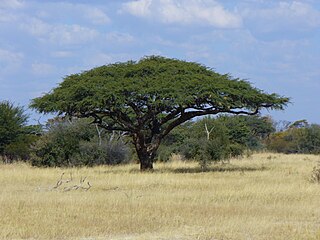Vachellia sphaerocephala is a plant of the family Fabaceae. The name comes from the shape of the thorns which do indeed resemble the horns of a bull. The tree has a strong, symbiotic relationship with a species of stinging ant, Pseudomyrmex ferruginea. This tree is endemic to Mexico.

Vachellia erioloba, still more commonly known as Acacia erioloba, is a tree of southern Africa in the family Fabaceae. Its preferred habitat is the deep dry sandy soils in parts of South Africa, Botswana, the western areas of Zimbabwe and Namibia. It is also native to Angola, south-west Mozambique, Zambia and Swaziland. The tree was first described by Ernst Heinrich Friedrich Meyer and Johann Franz Drège in 1836. The camel thorn is a protected tree in South Africa.

Vachellia caven is an ornamental tree in the family Fabaceae. Vachellia caven is native to Argentina, Bolivia, Chile, Paraguay, and Uruguay. It grows four to five metres tall and bears very stiff and sharp white thorns up to 2 cm in length. It blooms in Spring, with bright yellow flowers 1 cm to 2 cm in diameter.

Vachellia nilotica is a tree in the family Fabaceae. It is native to Africa, the Middle East and the Indian subcontinent. It is also a Weed of National Significance in Australia as well as a Federal Noxious Weed in the United States.
Leslie Pedley was an Australian botanist who specialised in the genus Acacia. He is notable for bringing into use the generic name Racosperma, creating a split in the genus with some 900 Australian species requiring to be renamed, since the type species of Acacia, Acacia nilotica, now Vachellia nilotica, had a different lineage from the Australian wattles. However, the International Botanical Congress (IBC) in Melbourne in 2011 ratified their earlier decision to retain the name Acacia for the Australian species and to rename the African species.

Vachellia aroma is a small, perennial, thorny tree native to Peru, Chile, Argentina and Paraguay. Some common names for it are aromita, aromo negro, espinillo and tusca. It is not listed as being a threatened species. Although some sources say that Vachellia macracantha is synonymous with Vachellia aroma, genetic analysis of the two species has shown that they are different, but that they are closely related.

Vachellia xanthophloea is a tree in the family Fabaceae and is commonly known in English as the fever tree. This species of Vachellia is native to eastern and southern Africa. It can be found in Botswana, Kenya, Malawi, Mozambique, Somalia, South Africa, Swaziland, Tanzania, Zambia and Zimbabwe. It has also become a landscape tree in other warm climates, outside of its natural range.
Vachellia anegadensis (pokemeboy) is a species of legume in the family Fabaceae. It is found only in the British Virgin Islands. Its natural habitats are subtropical or tropical dry forests, subtropical or tropical dry shrubland, sandy shores, and rural gardens. It is threatened by habitat loss.
Vachellia belairioides is a species of legume in the family Fabaceae. It is found only in Cuba, confined to Holguín Province in northeastern Cuba. It is threatened by habitat loss.
Vachellia cernua is a species of legume in the family Fabaceae. It is found only in Somalia, and is threatened by habitat loss.
Vachellia chiapensis is a species of leguminous tree in the family Fabaceae. It is found only in Mexico.
Vachellia daemon is a species of legume in the family Fabaceae found only in Cuba. It is threatened by habitat loss.
Vachellia origena is a species of legume in the family Fabaceae. It is found in Eritrea, Ethiopia, and Yemen.
Vachellia permixta is a species of legume in the family Fabaceae. It is found in Botswana, the Northern Provinces of South Africa, and Zimbabwe.
Vachellia prasinata is a species of legume in the family Fabaceae. It is found only in Ethiopia. It is threatened by habitat loss.
Vachellia roigii is a species of legume in the family Fabaceae found only in Cuba. It is threatened by habitat loss.
Vachellia zapatensis is a species of legume in the family Fabaceae found only in Cuba.

Vachellia is a genus of flowering plants in the legume family, Fabaceae, commonly known as thorn trees or acacias. It belongs to the subfamily Mimosoideae. Its species were considered members of genus Acacia until 2009. Vachellia can be distinguished from other acacias by its capitate inflorescences and spinescent stipules. Before discovery of the New World, Europeans in the Mediterranean region were familiar with several species of Vachellia, which they knew as sources of medicine, and had names for them that they inherited from the Greeks and Romans.

Vachellia reficiens, commonly known as red-bark acacia, red thorn, false umbrella tree, or false umbrella thorn, is a deciduous tree or shrub of the pea family (Fabaceae) native to southern Africa, often growing in an upside-down cone shape and with a relatively flat crown.
Vachellia natalitia is a species of legume in the family Fabaceae.







